Tapas, Vermouth, and Goya
Spain’s capital is an unending feast of eating and drinking. Madrid has as many restaurants as New York City with only 75% of the population. Los Gatos, a nickname for the locals, also have more bars to choose from, per capita, than any city in Europe. So let’s dive in!
A Short History
Modern-day Madrid has been inhabited since prehistoric times. The Romans defeated Carthage to take control of the Iberian Peninsula which, in turn, fell to the various Germanic tribes, including the Visigoths in the fifth century A.D.
By the 10th century, Moors from North Africa had taken control of the area and built a small fortified city where the Royal Palace stands today. Alfonso VI defeated the Moors in 1085, changing mosques to churches.
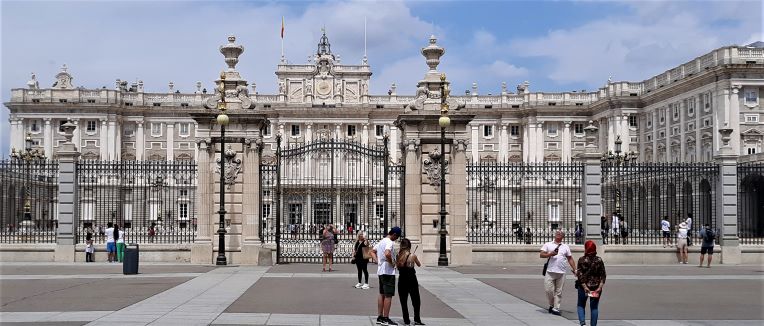
Madrid became the capital in 1561 when King Philip II moved there with his royal entourage. Spain grew incredibly rich with the theft of riches from the New World and Madrid went on a building spree that included the Palacio Real de Madrid, the Prado, and the Puerta de Alcalá.
The Napoleonic Wars and loss of New World colonies in the early 1800’s left Spain broke and revolts undermined the government.
Decades of unemployment and poverty eventually led to a military uprising and the Spanish Civil War in 1936. Madrid was held by the Republic (the democratically elected government of Spain), but the rebel Fascists, led by Francisco Franco, and supported militarily by Nazi Germany and Fascist Italy, attacked the city. Franco’s army laid siege and German Luftwaffe bombed Madrid, resulting in high civilian casualties.
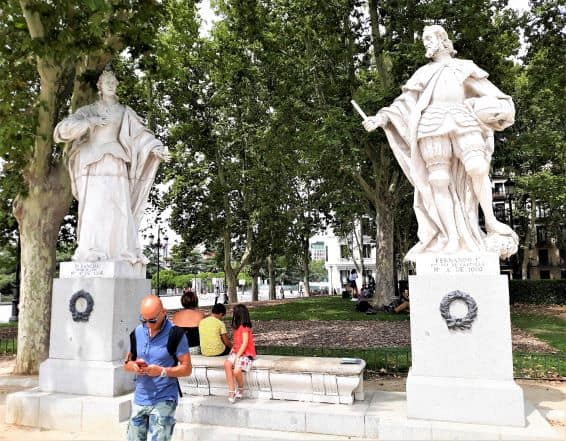
Madrid fell to the Fascists in 1939 and Franco installed himself at dictator of Spain. Franco ruled with an iron fist, sending political enemies to concentration camps and kidnapping the children (some estimates say 300,000 children) of former enemy combatants.
When Franco died in 1975, 36 years of fascism came to an end and democracy was restored. The standard of living has increased (Spain was once one of the poorest countries in Europe) and it has the fifth largest GDP in the EU. However, the unemployment rate remains high, second only to Greece in the EU.
Foodie Madrid
Spain is an incredible foodie country. And, in Madrid, you can find all the best that Spain has to offer.
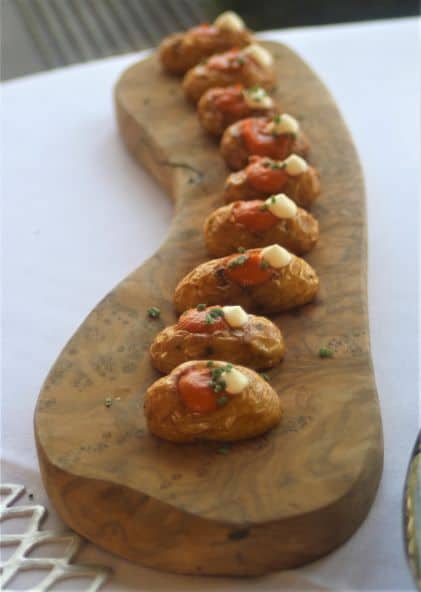
One important thing to know when dining in Madrid is the different kinds of dishes you can order.
Tapas: A small plate, snack sized. Usually inexpensive. Order several if you want a full meal, but it’s way more fun to go from place to place and get one or two tapa in each restaurant.
Racione: A full plate, like an entree. Don’t make the mistake of ordering several racione, thinking they are tapas. Your stomach and wallet will not be pleased.
Bocadillo: A small, usually inexpensive, sandwich served on a baguette. Often served in cafes and tapas bars.
Pintxo: Basque (a region of Spain and France) tapas.
Tapas
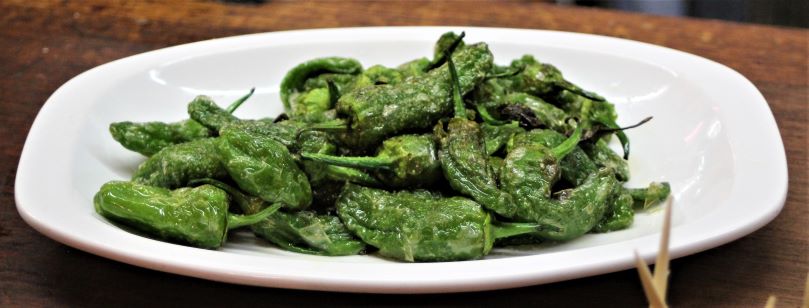
There are plenty of high-end and Michelin starred restaurants in Madrid. But the best way to get inside the city is to sample the countless traditional tapas bars. Look for restaurants with a plaque in front of them. These are awarded by the City of Madrid to restaurants that have been in operation for at least 100 years. You don’t get to the century mark by serving slop!
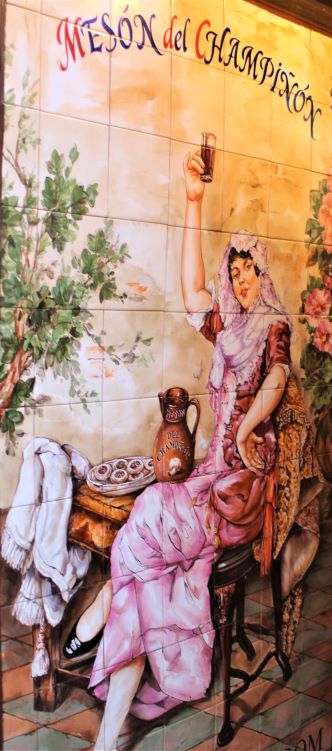
No one is 100% certain who or when tapas was invented. But, the tapas origin story from Cadiz in Andalusia is my favorite, so that’s one I go with. According to the legend, King Alfonso XIII was traveling through Cadiz when he stopped for a glass of wine. The waiter covered the glass with a slice of ham to keep the sand from windy Cadiz out of the royal cup (variations of the story say it was to keep out fruit flies). His Majesty liked the practice so much that he asked for a “tapa” (a cover) with his drink.
No matter where tapas was invented, Madrid has perfected the tradition of bars serving little plates of food with a drink. My absolute favorite thing to do in Madrid is to pick a neighborhood and go from place to place, ordering a tapa or two along with a drink, and then heading to the next place, never spending more than half an hour in any one tapas joint.
In fact, I love this Spanish tradition so much that I try to practice something similar called The Grazing Method whenever I visit a new city.
One tip: Tapas often come free with a drink. Tapas bars usually don’t advertise this fact so the best way to find out is to order a drink and wait. If a tapa shows up, you’re golden! If not, you can always order one.
Each tapas place has their own specialty. Look at what everyone else is getting or ask your waiter, and jump right in.
Mushrooms
Mesón del Champiñón has been cranking out their famous mushroom tapas since 1964. There is a cavern-like restaurant in the back, but the way to experience this place is to sidle up to the bar and order a plate of their famous mushrooms. The cap is filled with a piece of chorizo, but vegetarians can order the dish without.

The plate arrives with each fungi having two toothpicks sticking straight out. Confusion ensues until you watch another patron carefully use the toothpicks to lift the toadstool to their mouth and devour it in a single bite. Or, copy the guy in the painting on the wall.

Mesón del Champiñón also has outstanding Padrón peppers.
Patatas Bravas
Patatas Bravas is a famous potato dish, sort of similar to what we know as Home Fries in the U.S. Potatoes are cubed, par boiled, then fried until crisp. Nothing especially unique there, but what makes the Patatas Bravas is the sauce. A smooth and spicy tomato sauce is served for dipping.
The sauce is key. All the good places make the sauce in house and each has their own twist. The Bravas Sauce gets its kick from smoked paprika, not cayenne, which gives the dish a nice depth of flavor, but not too much heat.
A lot of people who I like and respect say Docamar makes the best Patatas Bravas in Madrid. And yes, they do a fine job.
But, allow me to offer up Casa Toni. This place is rustic in the best way possible with tables crammed into the tiny dining room and bar. There are tables upstairs, too, but why go there and miss all the action downstairs?
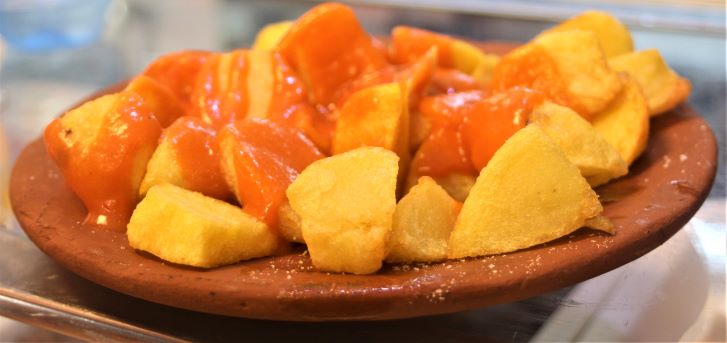
The potatoes here are crispier than Docamar’s and I really like Casa Toni’s Bravas Sauce. And, their fried eggplant is to-die.
Casa Toni is my absolute favorite tapas bar in Madrid.
Gambas al Ajillo
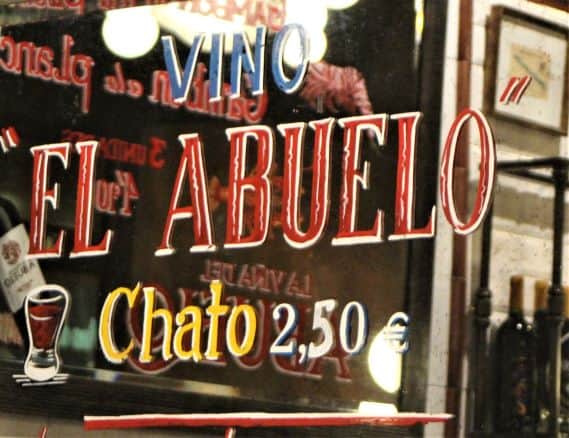
Back in the day (before the Spanish Civil War), La Casa del Abuelo thrived selling sandwiches. But bread shortages during the war forced them to diversify and now Abuelo is famous for their Gambas Al Ajillo (Garlic Shrimp). The dish comes sizzling in a ceramic bowl with oil and garlic.
But, I enjoy going to Abuelo for their house sweet wine. It’s fruity and intense and goes nicely with their Salmorejo Cordobes, a garlicky tomato soup thickened with bread. Delightful.
Huevos Rotos
Huevos Rotos (literally, Broken Eggs) is a fast and tasty combination of french fries topped with a fried egg. The dish is also served with jamon (ham) or chorizo. Served hot, the “Broken Egg” moniker comes from the the way the dish is eaten. Once served, the egg yolk is pierced with the customer’s knife, spilling it all over the hot potatoes.
Los Huevos de Lucio has eggs in the name (Huevos), so you know it’s good. And Taberna La Carmencita makes a nice Huevos Rotos as well. Carmencita’s spin is that in addition to offering jamon or chorizo, they also have Huevos Rotos with Morcilla (Spanish Blood Sausage).
For vegetarians, just request yours “Vegetariano.”
Tortilla
First things first, we’re not talking about the tortillas you get in Mexican and Tex Mex joints. The Tortilla in Spain is an omelette. Yes, the Spanish love their eggs and eat Huevos all day long.
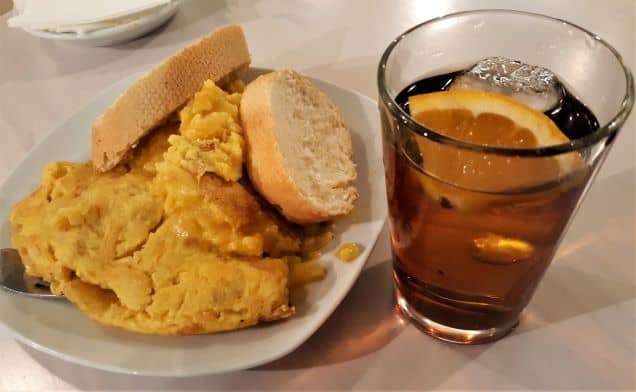
The traditional Tortilla is served with potatoes (Tortilla de Patatas), and sometimes onions (Cebolla), but lots of places are experimenting with Tortilla recipes to create new and exciting dishes.
My favorite place is Pez Tortilla. They offer the traditional Tortilla (with onion) but also a Mozzarella & Pesto Tortilla and a Shrimp & Tortilla. Best of all, you can top it with their famous Bravas Sauce!
Basque Tapas
The Basque people live in an area called Basque Country where Spain and France meet on the Atlantic Ocean at the Bay of Biscay. Basques are an ethnic group with their own unique language and culture and the Basque people enjoy a certain amount of political autonomy in the Basque Autonomous Community. There are vibrant Basque expat communities in Spain and France and all over the world. Boise, Idaho, for instance, has a lot of people of Basque heritage.
Basque cuisine is world-renowned and the gastronomic capital, San Sebastin, is a foodie destination with many Michelin starred restaurants and outstanding Pintxos joints.
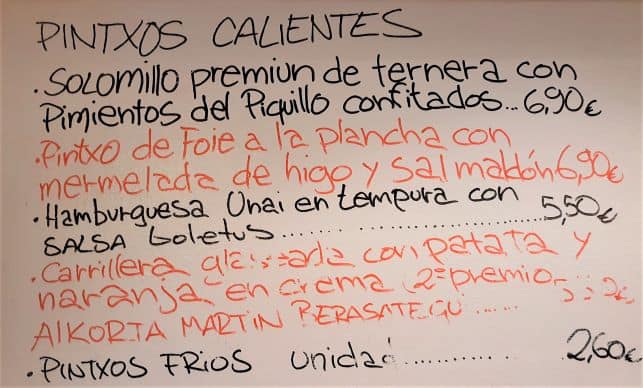
Pintxos is the Basque version of tapas, with lots of little fried goodies and morsels piled on bread, held together with toothpicks.
The Pintxis are scribbled are a white board at Txirimiri. The dishes are excellent and the wine list is top-notch. There are a couple Txirimiri locations in Madrid, but this is no chain. Some of the best tapas in Madrid.
Porras
You might be familiar with the Churro, a dough that is squeezed through a star shaped nozzle and into a fryer to create a long, sweet, and crispy treat.
In Madrid, they eat Churros for breakfast, but they also have another option; the Porra. Porras are made with the same dough, but a wider nozzle is used to create something similar to a Churro, only fatter.
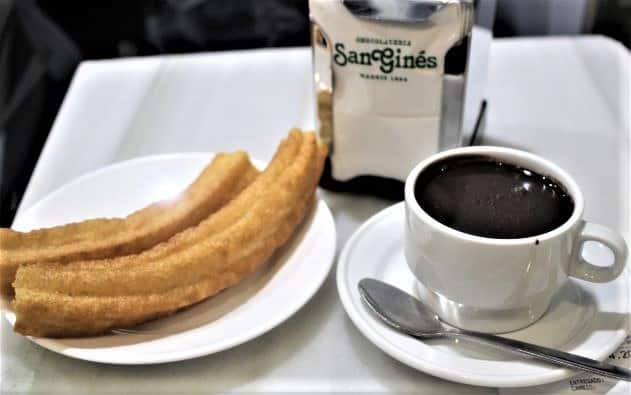
Order a Churro or Porra with a cup of thick hot chocolate and dip your Spanish fried dough in the liquid. It’s very rich and decadent.
Chocolatería San Gines is the most famous place in Madrid to get Chrurros or Porras and for good reason. They’ve been in business since 1894. If you want to grab your Porras to go, stand in line at one entrance. Or, grab a table next door and look at the pictures of all the famous people who have dined and dunked before you. And, if you get a Porras craving at 3 in the morning, they’re open 24 hours a day, 7 days a week!
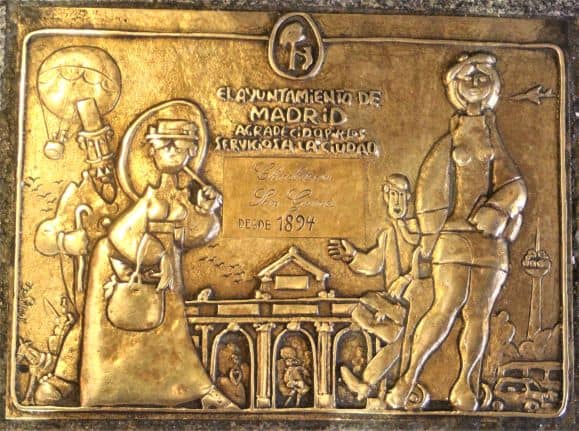
Napolitana de Chocolate

Spain may be famous for Churros con Chocolate, but frankly, I’m much more partial to another sweet treat in Madrid; Napolitana de Chocolate. It’s similar to France’s Pain au Chocolate. And, I know it’s probably heresy, but I like the Spanish version better. Don’t get me wrong, I like Pain au Chocolate very much. But, at La Mallorquina in Madrid, the croissant seems a bit flakier and, best of all, the chocolate inside is gooey, almost like a grenache.
Like I said, that might not be a popular opinion, but I’m calling ’em like I see ’em. Besides, La Mallorquina has been around since 1894 so they’ve got the Napolitana de Chocolate down.
Drinking in Madrid
Vermut de grifo (Vermouth on tap)

Forget everything you think you know about Vermouth. The Vermouth you get in Spain is a totally different animal than the drink your grandmother used to consume.
In Madrid, Vermouth is aged in barrels to give it flavor and caramel coloring. It is also infused with botanicals to give it flavor and aroma. Vermouth is served fresh on tap, straight up. Sometimes a slice of citrus and/or soda water is added.
Often, bars will have their own “Vermut Casero” or house made vermouth. They will add flavors like orange blossom or chile pepper to the Vermouth.
My favorite place for house made Vermouth is El 7 de la Cava. It’s a little hole in the wall with a rotating menu of Vermut Casero. Karen ordered the spicy one with that came with a slice of hot pepper on the side. It was too much for her so we traded (I ordered the Classico). In addition to a great selection of Vermouth, the atmosphere is chill and you get a little tapas with each drink you order (a practice that used to be customary, but now is more of a rarity in Madrid).

Another great spot is El Anciano Rey de los Vinos. They have good tapas with Vermut de grifo (Vermouth on tap).
And then there’s Casa Labra. Known for their fried cod tapas, they also have good Vermouth. On the wall of Casa Labra is a sign reading “Se Prohibe Cantar” (No Singing). The story I was told was that back in the day, people were not allowed to sing in bars. The reasoning went that singing could lead to more rowdy, drunken antics. In some places with a sense of humor, like Casa Labra, the sign remains. I’m sure no one is getting arrested for belting a verse of “Twist and Shout,” but just to be safe, I left my karaoke machine at home.
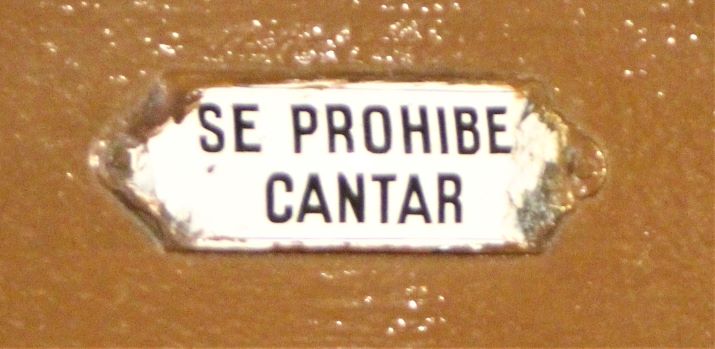
Cocktails
Vermouth is great, but sometimes you want a cocktail and luckily Madrid is full of amazing cocktail bars.

In fact, it is home to Salmon Guru which some folks think is the best bar in the world. Unique cocktails like the Chilpotle Chillón and Little Hell Boy are served with creativity not seen elsewhere.
1862 Dry Bar fits in perfectly in the hipster Malasala neighborhood. Creative cocktails that change regularly and chill music makes this a great spot to relax.
Madrid is seeing more influence from former colonies. Immigrants from Central America have brought their culture to the city. It’s not unusual to see taco stands near some of the busiest tourist sites and Mojitos are popping up on drink menus. Oddball bar and restaurant El Imperfecto makes a mean Mojito.
Beer

Just as Vermouth is undergoing a rebirth in Madrid, so is beer. Like cities all over the world, the craft beer renaissance is taking a hold here.
Pez Tortilla isn’t a bar, but they have a nice selection of craft beers to go with their fantastic Spanish Omelettes (Tortilla). And, the vibe is upbeat and fun, if a bit crowded. Highly recommended.
Fogg Bar Birras & Cheese is pretty hip but they have a great selection of craft beers as well with many from the Madrid area.
Of course, you could just pop into into any tapas joint and have a caña (about 7 ounces of beer) of whatever they have on tap.
Things to do in Madrid
Goya
No artist is as closely tied to Madrid as Francisco Goya. Starting his professional life as a Royal cartoonist, Goya rose through the king’s ranks to eventually become the Chief Court Painter. But, Goya seemed less than taken by the royal family as can been seen in his than flattering portrait “Charles IV of Spain and His Family.” A pretty rough treatment of his boss.
Goya was deaf for much of his adult life and later became a recluse as an old man, during which he created The Black Paintings. These 14 images were painted directly on the plaster of his farmhouse outside Madrid and likely were never intended to be publicly displayed.
Goya was known to be politically aware, but when the French army invaded Spain in 1808, he took commissions from French patrons. After the war, when Spain was liberated, Goya painted his masterpieces “The Second of May 1808” and “The Third of May 1808,” both of which show the Spanish side favorably and the French side negatively. Talk about playing both sides.
There are many places where Goya’s work can be seen. First and foremost is the Prado, which has 152 of his paintings in their collection, including “Charles IV of Spain and His Family, “The Second of May 1808,” “The Third of May 1808,” “La Maja Desnuda,” and “La Maja Vestida” as well as the deeply disturbing Black Paintings.
Real Parroquia de San Antonio de la Florida
People often ask why I spend so much time going to churches when I travel. My answer is “That’s where the art is.” When there’s great art in a museum, I go there. When there’s great art on the street, I go there. And, when there great art in a church, I go there.
Real Parroquia de San Antonio de la Florida is one of those places with great art. Goya painted an incredible fresco on the ceiling of the church depicting a miracle by Saint Anthony of Padua, a 13th century friar from Lisbon. Goya made the creative decision to paint the scene of Anthony in Spain rather than Lisbon.
Goya died in Bordeaux in 1828 and was buried there. Years later, his remains were returned to Madrid and are interred at Real Parroquia de San Antonio de la Florida.
Even if you’re not interested in Goya, a visit to the Royal Palace, Palacio Real is a highlight in Madrid. The baroque palace has 2,800 rooms, 50 of which are open to the public. A handful of Goya paintings are on display (but why, it seems Goya loathed the Royal Family) along with several other masterpieces by other artists, original Stradivarius violins, and a lavish throne room.
Real Academia de Bellas Artes de San Fernando
Goya was director here and now several of his paintings hang at the museum.
Basilica of San Francisco El Grande

The Basilica of San Francisco El Grande was built on the spot where a church was founded by St. Francis of Assisi.
Near the alter is Goya’s San Bernardino de Siena predicando ante Alfonso V de Aragón. Is this Goya’s greatest painting? No. But, it is well done and features an interesting aspect of his work. In the lower right hand side of the painting is the one figure who is not looking up at St. Bernie. Instead, he looks back at us. That guy is Goya. The artist often employed this self portrait device in his paintings.
The best reason to visit this church is it’s massive dome (the fourth largest in Europe) Inside, the ceiling is painted with eight magnificent frescoes. Stunning and spectacular.
Don’t miss wandering the back rooms which are all filled with paintings from other lesser known, but accomplished, Spanish artists.
Picasso
Pablo Picasso is my favorite 20th century artist, narrowly edging out Frida Kahlo. I love both artists, but Pablo gets the nod in my book due to his long and productive life. Who knows what Frida could’ve accomplished had she lived longer?
Pablo Picasso was born in Andalucia and moved with his family to Barcelona as a teenager when his father took a position as a teacher at the School of Fine Arts.
There is an excellent Picasso Museum in Paris, but the one in Barcelona is my favorite. It doesn’t house as many masterpieces as others, but if you’re interested in Picasso’s early development as a schoolboy and his early Blue Period work, then you’ll love the Picasso Museum in Barcelona. Here is where you’ll see his works like “Science and Charity” and “Portrait of the Artist’s Mother” which show Picasso’s mastery of realism as a teenager. And yes, that is a shot at anyone who has ever said about one of Pablo’s abstract works “I could do that.” No. No, you couldn’t.
Young Pablo enrolled in Madrid’s Real Academia des Bellas Artes de San Fernando, but instead of going to class, he haunted the Prado Museum. He returned to the city in 1901 as a 19 year old and co-published an art magazine. It was in Madrid in 1901 that Picasso may have begun his Blue Period paintings.
On April 26th, 1937, German planes bombed the Basque town of Guernica, a stronghold of Spanish Republicans who were fighting Francisco Franco’s Facist Nationalists in the Spanish Civil War. Franco had invited the Germans to bomb the city, which they happily did even though the town held little military significance. The town was reduced to rubble and civilian deaths (mostly women and children) were widespread.
When news of the Guernica bombing reached Picasso in Paris, he immediately began work on the initial sketches which would instruct his masterpiece.
The painting itself is huge, measuring over 11 feet high and 25 feet wide. It is also unusual in that it doesn’t make use of Picasso’s genius for color, instead being black and white and gray. The painting depicts the chaos of war with fragments of terrible images including a mother holding a dead baby, a fallen soldier, a fleeing women, all watched in disbelief by a bull (the symbol of Spain).
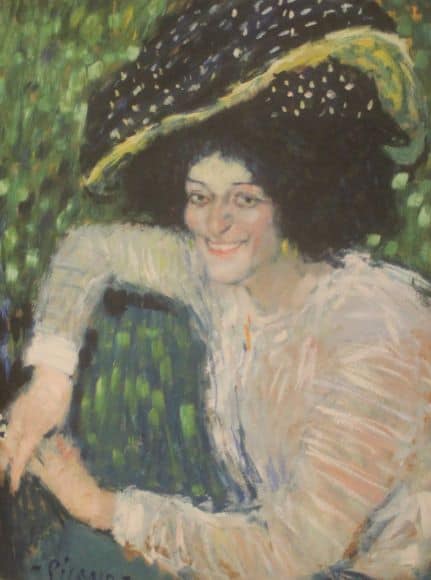
Picasso’s work has been well-traveled, touring Europe, South America, and the United States before being housed in New York’s Museum of Modern Art for safekeeping. Picasso had stipulated that Guernica would not be returned to Spain until the country was free and Fascism was abolished, and, even though Franco tried to get the masterpiece back, it was not returned until after the dictator died and democracy was restored.
Today, Guernica resides in the Museo Nacional Centro de Arte Reina Sofía along with several the Picasso’s early sketches that later informed the painting. Reina Sofia also has several other Picasso pieces on display along with works by Dali and many other 20th century artists.
Be sure to get your tickets in advance.
Parque del Buen Retiro
The Prado Museum is just a 10 minute walk from the Museo Nacional Centro de Arte Reina Sofía, so you might be tempted to do both in the same day. I can’t run your life, but I advise against it. For me, more than one big museum in a day is exhausting and after a while I start to tune out and my eyes glaze over.
Instead, I recommend doing the two museums on different days. Then, after visiting Reina Sofia in the morning, you can head to Parque del Buen Retiro for a nice stroll and picnic.

The 350 acre public space used to be for the exclusive use of the Spanish Royal Family. Today, residents of the city enjoy the walking paths, gardens, and concerts at the bandstand.
Mallorca Pasteleria is a short Uber (less than 1.5 miles) from Reina Sofia. Stock up on provisions for a picnic. From there, Parque del Buen Retiro is a quick five minute walk away.
On your way to the park, you’ll pass by the famous Puerta de Alcalá. This gate used to mark the entrance to the city, but now Madrid has expanded well beyond the Alcala Gate.
Prado
The Prado is one of the world’s greatest art museums, right up there with the Louvre, The Metropolitan Museum in New York, the Art Institute in Chicago, Te Papa in New Zealand, the Shanghai Museum, and the Uffizi in Florence.
And like those museums, the Prado can be overwhelming in its size and scope.
Originally opened in 1819 to showcase Spanish art (and prove its worth to the rest of the world), the Prado boasts masterpieces by El Greco, Rembrandt, Rubens, and Titian as well as a large collection of Goya works.
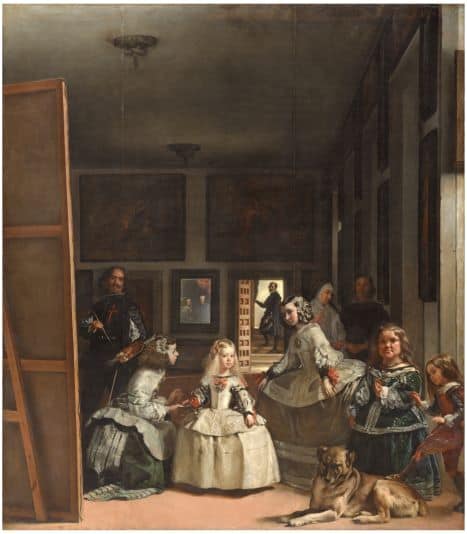
Perhaps the most famous painting in the gallery is Las Meninas by Diego Velázquez. The painting depicts several people from the court of King Philip IV of Spain and Portugal in the Royal Alcazar of Madrid. Central in the canvas is Margret Theresa, Philip’s young daughter. What makes the painting so special is Velázquez’s use of perspective. The painter shows himself painting a canvas (invisible to us, the viewer), but a cleverly placed mirror at the rear of the room shows us what Velázquez sees, the King and Queen. While the formality of the royals posing is given little importance in Las Meninas, the candid snapshot of a girl and her entourage, including her dog, takes center stage. Ingenious breaking of the fourth wall. I could look at this masterpiece all day,
Dutch painter Hieronymus Bosch’s tri-paneled Garden of Earthly Delights is another must-see exhibit at the Prado. Bosch painted Garden over the course of 20 years from 1490 to 1510. Each of the three panels, painted on oak, depicts a different scene. The left panel shows Adam and Eve in the Garden of Eden with a God figure presenting Eve to her awakening husband. The center panel has nude humans, male and female, enjoying sensory pleasures from food to pleasures of the flesh. On the right panel, the frolicking humans are now in Hell, reaping what they have sown. Homes are on fire and people are tortured, violated, and eaten by grotesque animals.

Sounds like a fun weekend!
Peeking behind the panels, another painting reveals itself. When the left and right panel are folded in and cover the center panel, there is an image of the earth, pre-creation. When looking at all the images and detail in The Garden of Earthly Delights, I can easily see why it took Bosch 20 years to complete this masterwork.
I start to get a little restless if I spend too much time in a museum, Even in a place as glorious as the Prado, two hours is about as long as I can go. Unless, they have a nice cafe or restaurant, which the Prado certainly does not.
But, the Prado does have a great audio guide available. Best of all, you can select how long (approximately) you want to spend in the museum and the guide will take you to the highlights that fit your time frame.
Be sure to get your tickets in advance. Otherwise, you’re likely to be disappointed.
Ernest Hemingway
American writer Ernest Hemingway had a long relationship with Spain, most famously writing about the running of the bulls during Pamploma’s Festival of San Fermin in “The Sun Also Rises.”
During the Spanish Civil War, Madrid was under siege by Franco’s Fascists and bombed heavily. Hemingway was in the city and wrote his only play “The Fifth Column” here.
Hemingway, a notorious drinker, made La Venencia his watering hole of choice. That’s likely because Republican soldiers fighting the fascists also favored La Venencia. The soldiers passed tidbits to the journalist they dubbed “Don Ernesto.”
La Venencia has done nothing to try and keep up with the times. Faded and torn sherry posters decorate the walls of the bar that serves only sherry, a drink that is hopelessly out of date with today’s tastes.
Tapas choices are simple, green olives, Manchego cheese, cured tuna, and your bill is written with chalk on the bar.
Many places play up their association with famous customers. Café A Brasileira, for example, has a bronze statue of the poet Fernando Pessoa sitting outside at a table. But, there’s nary a mention of Hemingway at La Venencia. Instead, locals enjoy sipping sherry in the rustic atmosphere.
One last note, taking pictures is severely frowned upon inside the bar. But, there is an unofficial La Venencia Facebook page with some interior photos.
Markets
One of my favorite things to do is visit a city’s markets. Nothing gives you a better feel for the most popular things to eat. And, if you’re staying in an apartment, you can see what’s in season to cook up in your kitchen.
Mercado de San Miguel
Mercado de San Miguel gets all the press in Madrid, and for good reason, it’s packed with beautifully presented and tasty food.
But here’s the thing. It’s a tourist trap. That doesn’t mean you shouldn’t go to Mercado de San Miguel, you definitely should. Just know that it’s not a place where locals typically hang out and you will pay a premium for the food here. Still, you should go. The place is mesmerizing.

Mercado de San Antón
My favorite market in Madrid is Mercado de San Antón, There’s tapas galore and lots of fresh produce. Bars serve a nice selection of beer and there’s outdoor dining that affords a great view of the city.
There’s even a shop that sells Spanish truffles. A big secret in the truffle trade is that Spain produces a lot of the world’s truffles. But, the Spanish don’t really like or eat truffles. So, Spanish truffles are exported to places like Italy where a “Product of Italy” sticker is slapped on the container and the Iberian Truffle is sold as Italian. This scam that exploits a loophole in EU law has been going on for decades.
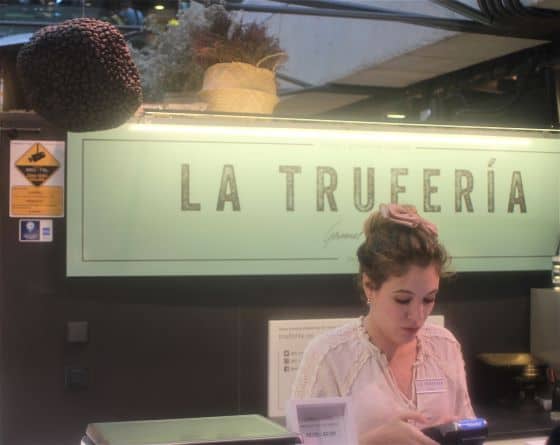
After visiting the market, Plaza de Chueca is just a block away. Not famous and not on any list of must-see squares, Plaza de Chueca is small but has a hip vibe with cafes, bars, and boutiques.
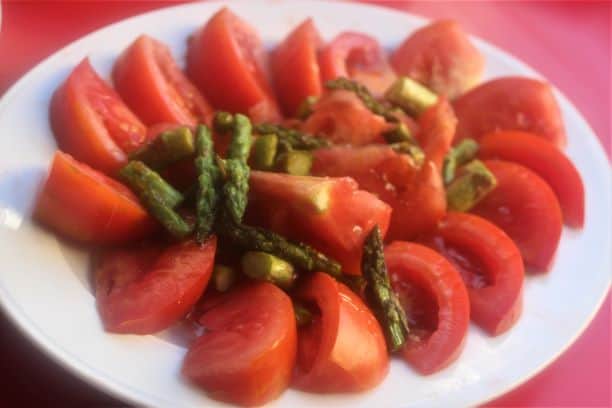
Street Signs
A fascinating piece of street art is on the corner of almost every street in the historic areas of Madrid. And to see them all you have to do is look up!
Tiles (usually 3×3 or 4×4) are painted with the name of the street or plaza and a picture that represents it.
The meaning of some signs, like Plaza Isabel II (she was forced into exile in France after the First Republic), are obvious. Others seem indecipherable like the Calle Angosta de los Mancebos which translates to Narrow Street of the Young Men. What? Even more perplexing is the picture on the tiles showing someone throwing roof tiles down on the street below, perhaps on the head of an adversary?)
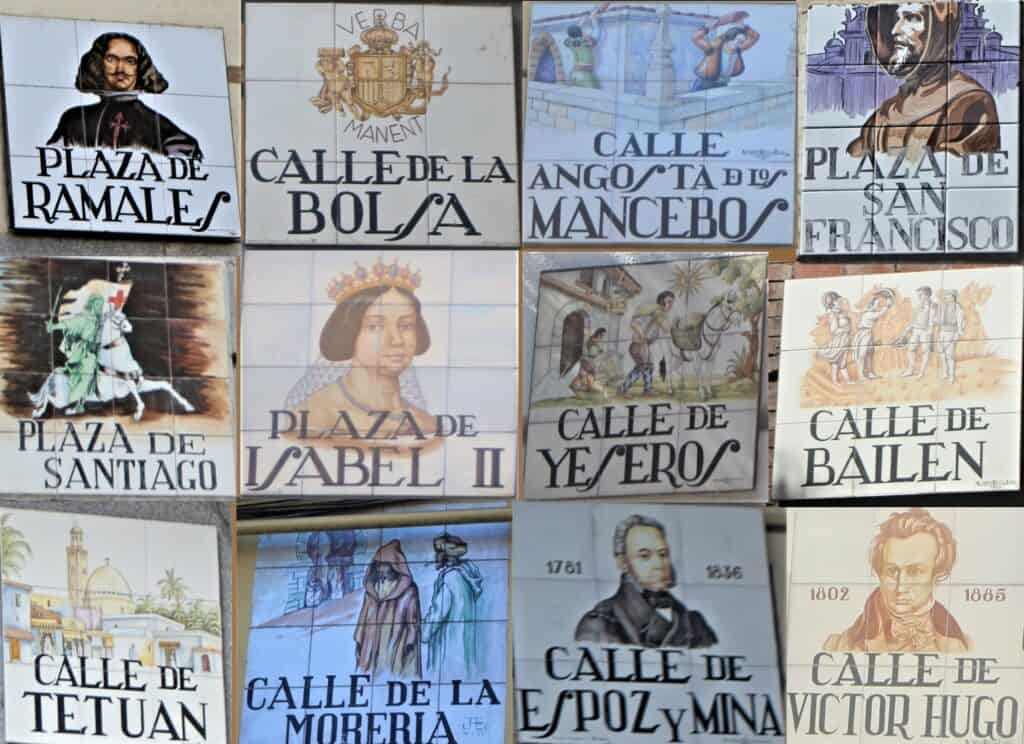
Whatever the meaning of each painting, I enjoyed looking at them. And, I’m sure I annoyed a lot of local motorists when I wandered into the street to get a better picture. Damn tourists!
Flamenco
Flamenco is the traditional folk dancing and music of Spain. Flamenco typically features a dancer and a guitar player (or players). Each movement by the dancer has a special meaning and the entire performance is charged with deep emotion.
Flamenco originated in southern Spain. There is still a strong Flamenco culture in Andalusia, with regular amateur and professional performances in almost every city and town. But, the top performers work in Madrid. After all, the Beatles left Liverpool for London, didn’t they?
There are tons of places that have Flamenco performances and if you want to see one of the top Flamenco artists you’ll need to book a ticket. Many of the venues double as restaurants so you may be required to buy a ticket that includes a meal.
Alternatively, you can see a more informal performance at a bar or cafe. Ask around or just look for a sign outside advertising a performance.
Corral de la Moreria is the most prestigious Flamenco spot in Madrid. They’re also the oldest venue in Madrid, opening in 1956. Expect to pay about fifty Euro for the show (Dinner extra).
Casa Patas and Las Tablas also offer top-line performances with dinner. Be sure to book ahead. Places like Patas are small and intimate, so seating is limited.
Teatro Flamenco Madrid focuses more on the Flamenco experience (although you can buy drinks and snacks) and less of the meal/Flamenco package of other places. Because of this, tickets are a little less expensive, though the quality of the show is excellent.
Daytrips
Toledo
Toledo is the perfect day trip from Madrid. It only takes a half hour by train or 90 minutes by car to get there. The city’s rooftop perch and stunning architecture along with its stew of history and culture make it a spot ripe for exploring.
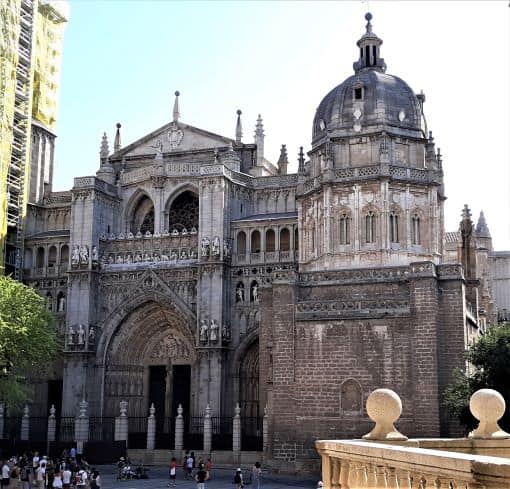
Toledo was a Roman city. After the fall of Rome, it was the capital of the Visogothic Kingdom for almost 200 years. When the Arabs conquered Toledo in the 8th century, the capital was moved and the city fell into decline.
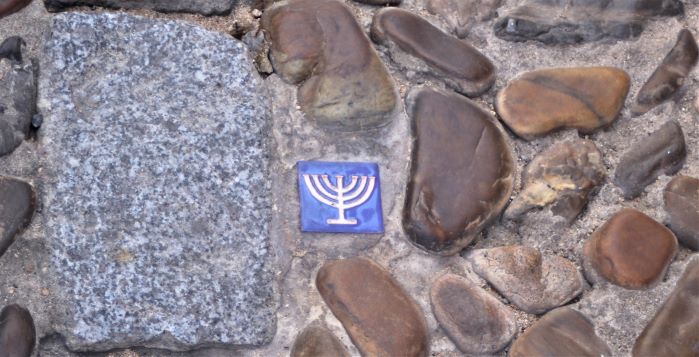
This period of Arab rule is when “The City of Three Cultures” was most evident. Jews, Christians, and Muslims all had thriving populations in the city. But, after the reconquest of Toledo by the Christian Alfonso VI in 1085, persecution increased until Jews were formally expelled from Spain in 1492, followed by the remaining Muslims in 1502.
Catedral Primada Santa María de Toledo (Toledo Cathedral)
A mosque stood on this site and one of the conditions of the Muslim’s peaceful surrender to Alfonso VI was keeping intact Muslim cultural artifacts, including the mosque. But, when Alfonso VI was away, his wife had soldiers seize the mosque and install an alter and hang a bell. When Alfonso VI discovered this, he had the soldiers who had broken his promise executed. Still, he didn’t prevent the construction of a great church on the site.

The Cathedral is the top site in Toledo, and for good reason. It is one of the greatest examples of High Gothic architecture and took almost 250 years to complete. Even today, the tower is undergoing a restoration.
Inside, there are dozens of chapels filled with artwork from masters like Titian, Caravaggio, and El Greco. The most famous is probably El Greco’s “The Disrobing of Christ.”
Synagogue of Santa María la Blanca (Ibn Shushan Synagogue)
Built in 1180 and originally known as Ibu Shushan Synagogue, the Synagogue of Santa Maria la Blanca is one of the best examples of the idea of the “City of Three Cultures” in Toledo.
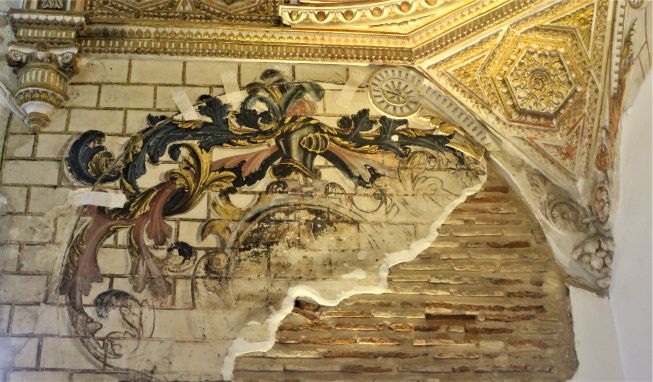
The synagogue was constructed during the time of Christian rule in Toledo, but designed and built by Muslim architects with Islamic stylings for a Jewish assembly. Because of the murderous Spanish Inquisition and the expulsion of Jews from Spain in 1492, there was no community for the synagogue. Today, it is owned and maintained by the Catholic Church.
Mosque of Cristo de la Luz (Mezquita Bab-al-Mardum)
Originally known as Mezquita Bab-al-Mardum, the name was changed when the Knights of St. John were given the structure by Alfonso VIII in 1186.
This is one of the ten mosques that originally stood in Toledo. Unfortunately, this is all that is left. Even so, you can get a glimpse of this important part of Toledo’s history.
El Greco
Doménikos Theotokópoulos, famously known as El Greko, was born in the Kingdom of Candia (Crete) in 1541, but spent the bulk of his adult life working in Toledo.
The El Greco Museum is in a converted house in the Jewish Quarter of Toledo. It has many of El Greco’s works on display (especially his later work) along with pieces from other Spanish artists. The museum also tells the interesting story of El Greco’s life.

Puente de San Martín (St. Martin Bridge)
This spectacular Medieval bridge, capped with fortifications, was one of the longest bridges built in its time. Walking across is quite an experience and one of the best spots to get a photo in Toledo. Thrill seekers can zipline across the river.
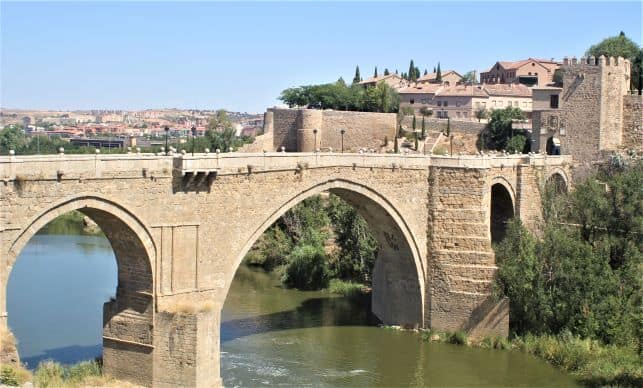
Romangordo
Only abut 250 people live in Romangordo. You’re not going to find the teeny town in any fancy guidebooks. It doesn’t have any great tourist attractions, although there is a small museum dedicated to village life.
But, there is an amazing collection of outdoor artwork that makes Romangordo worth a stop.
In 2016, the city hired artists from Extremadura to paint the facades of some local buildings. The artists used the trompe l’oeil technique to make the murals appear to be in 3-D. The realism of the project is accentuated by adding local residents to many of the paintings. The project has been met with such enthusiasm, that more paintings have been added and now total over 60 works.
It’s not easy to get to Romangordo. The train station is a half hour drive away so you probably need your own wheels. The town is about a 2 1/2 hour drive from Madrid, making it a good weigh point on the A-5, almost halfway between Madrid and Lisbon.
Transportation
Adolfo Suárez Madrid–Barajas Airport
Madrid’s International Airport (MAD) has non-stop flights to most major international cities, including non-stop service to several North American cities. Both the Metro and Cercanias stop at the airport.
Madrid Atocha train station
High speed rail service to many cities in Spain as well as Marseilles, France.
Plaza del Emperador Carlos V, 28045 Madrid, Spain
Metro
The Madrid Metro has 13 lines and covers most of the city. Trains are frequent and ticket kiosks are available in English.

Bus
The bus service in Madrid is called EMT (not to be confused with the EMT emergency service in the U.S.) Buy your ticket on board from the driver.
Cercanias
Cercanias is the commuter rail system in Madrid. Buy tickets at the kiosk, they have an English language option.
Tourist Ticket
If you’re planning on using a lot of public transportation, the tourist ticket gives you unlimited rides for 1-7 days.
Index of Things to Do in Madrid
Devour Tours
Great food tours. Highly recommended.
Museo del Prado
One of the finest collections of European art in the world including several Goya masterpieces.

Calle de Ruiz de Alarcon, 23, 28014 Madrid, Spain
Centro de Arte Reina Sofia
Spain’s 20th century art museum featuring Picasso and Dali, including Picasso’s Guernica.

Calle de Santa Isabel, 52, 28012 Madrid, Spain
Museo Thyssen-Bornemisza
The third of Madrid’s three great art museums.
Paseo del Prado, 8, 28014 Madrid, Spain
Palacio Real
Spain’s Baroque Royal palace.
Calle de Bailén, s/n, 28071 Madrid, Spain
Jardines del Cabo Noval
Gardens across from the Royal Palace contains some statuary from the palace facade.
Plaza de Oriente, 9, 28013 Madrid, Spain
Liria Palace
The most incredible privately held art collection with Goyas, Titians and a first edition Don Quixote. Reserve tickets at least a month in advance. Admissions extremely limited.
Calle de la Princesa, 20, 28008 Madrid, Spain
Ermita de San Antonio de la Florida
Chapel with incredible Goya frescoes.
Glorieta San Antonio de la Florida, 5, 28008 Madrid, Spain
Plaza Mayor
Plaza with lots of touristy dining and shopping spots.
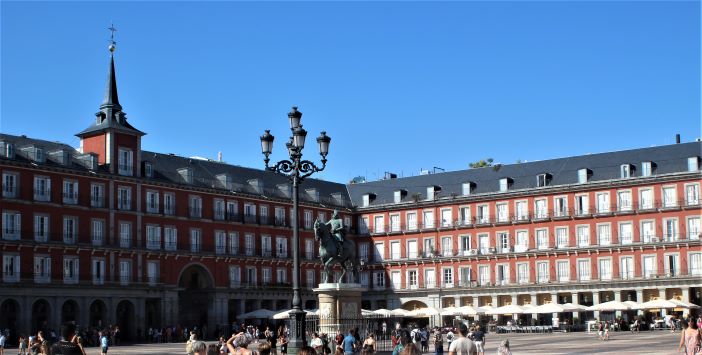
Plaza Mayor, 28012 Madrid, Spain
Iglesia de San Ginés
Church with El Greco’s “Expulsion of the Moneychangers from the Temple.”
Calle del Arenal, 13, 28001 Madrid, Spain
Real Basílica de San Francisco el Grande
Church featuring Goya’s San Bernardino de Siena predicando ante Alfonso V de Aragón.
Calle San Buenaventura, 1, 28005 Madrid, Spain
Corral De La Moreria
Good place for flamenco.
Calle de la Moreria, 17, 28005 Madrid, Spain
Museo de Historia
Museum features Goya’s “Allegory of the City of Madrid.” Free admission.
Calle de Fuencarral, 78, 28004 Madrid, Spain
Teatro Flamenco Madrid
Excellent Flamenco show.
Calle del Pez, 10, 28004 Madrid, Spain
Parque del Buen Retiro
Beautiful park with monuments. Great place for a picnic.
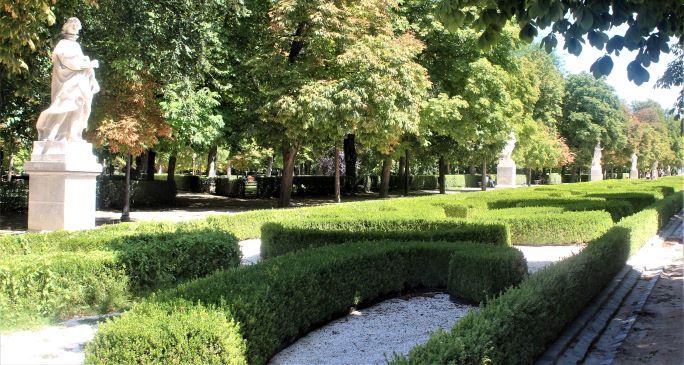
Plaza de la Independencia, 7, 28001 Madrid, Spain
Real Jardín Botánico
Botanical Garden near Parque del Buen Retiro.
Plaza de Murillo, 2, 28014 Madrid, Spain
La Tabacalera de Lavapies
Public art and performance space in a converted tobacco factory. Lots of free vents.
Calle Embajadores 53, 28012 Madrid, Spain
Las Tablas
Excellent flamenco spot.
Plaza Espana 9, 28008 Madrid, Spain
La Coquette
Blues bar.
Calle de las Hileras, 14, 28013 Madrid, Spain
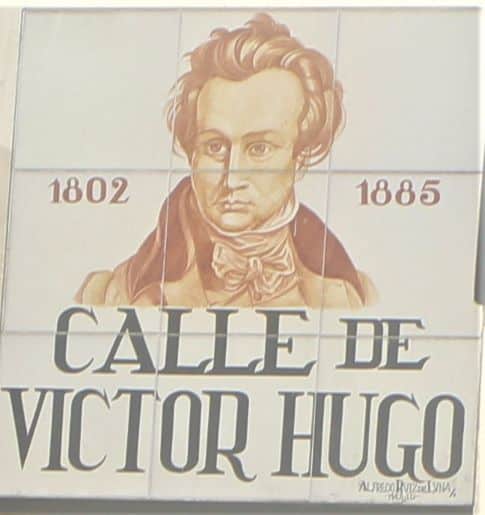
Estación de Chamberí
Madrid’s abandoned “ghost station.”
Calle de Luchana, 38-40, 28010, Madrid, Spain
Puerta del Sol
Very busy and crowded square with lots of tourists and entertainment.
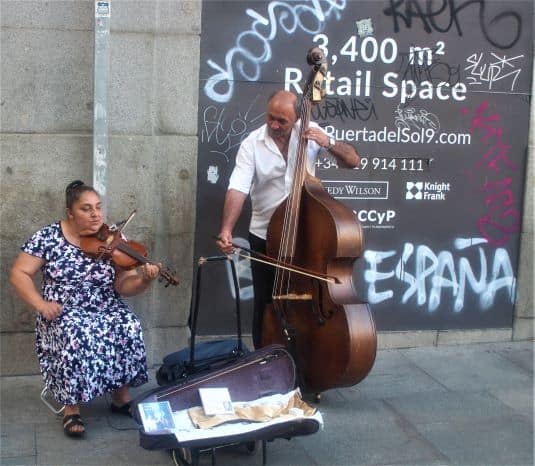
Puerta del Sol, 28013 Madrid, Spain
Real Academia de Bellas Artes de San Fernando
Several Goya works on display (he was a director at the Academy).
Calle de Alcalá, 13, 28014 Madrid, Spain
Casa Pueblo
Cool jazz bar with nightly live music.
Calle del León, 3, 28014 Madrid, Spain
Cafe Central
Live jazz.
Plaza del Ángel, 10, 28012 Madrid, Spain
Atocha Station Tropical Garden
Large tropical garden inside train station.
Estación de V, s/n 28045, Plaza del Emperador Carlos V, Madrid, Spain
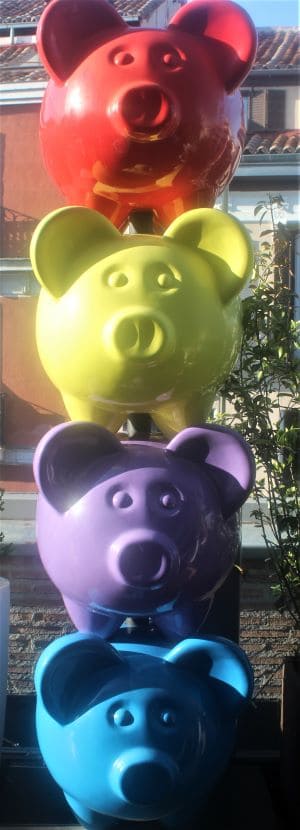
The Rocker Grandma
Statue honoring heavy metal loving grandma Ángeles Rodríguez Hidalgo.
Calle Peña Gorbea, 22, 28053 Madrid, Spain
San Lorenzo de El Escorial
Historically the royal residence. 28 miles from downtown.
Calle de Juan de Borbón y Battemberg s/n. 28200 San Lorenzo de el Escorial – Madrid
Toledo
Sinagoga de Santa María La Blanca

Jewish Synagogue built in an Islamic style is now maintained by the Catholic Church.
Calle de los Reyes Católicos, 4, 45002 Toledo, Spain
Mosque of Cristo de la Luz (Mezquita Bab-al-Mardum)
Mosque built 1,000 years ago.
Calle Cristo de la Luz, 22, 45002 Toledo, Spain
El Greco Museum
Museum dedicated to the painter who lived much of his life in Toledo.
Paseo Tránsito, s/n, 45002 Toledo, Spain
Puente de San Martín
Toledo’s Medieval bridge. Great spot for photos.

Bajada San Martín, 45004 Toledo, Spain
Romangordo
Trompe l’oeil artwork
Delightful 3-D paintings on many of the village’s facades.
Index of Food & Drink in Madrid
Restaurante Sobrino de Botin
The world’s oldest restaurant
Calle de Cuchilleros, 17, 28005 Madrid, Spain
DiverXO
Three Michelin stars.
NH Eurobuilding, Calle de Padre Damián, 23, 28036 Madrid, Spain
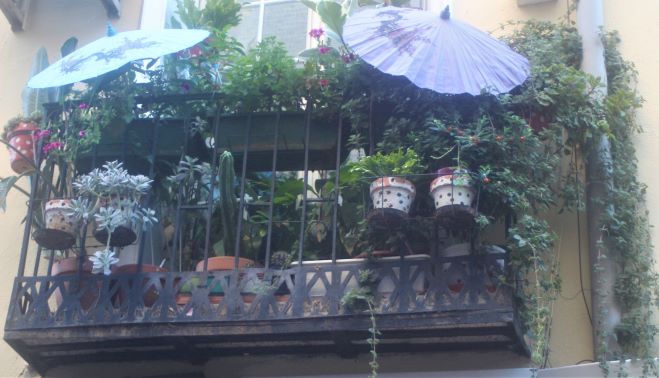
Juana La Loca
The place for Tortilla de patatas (with onions.)
Plaza de Puerta de Moros, 4, 28005 Madrid, Spain
Monasterio del Corpus Christi
Cloistered convent whose nuns sell delicious cookies.
Plaza del Conde de Miranda, 3, 28005 Madrid, Spain
Mercado San Miguel
Part produce market, part tapas.

Plaza de San Miguel, 5, 28005 Madrid, Spain
Casa Gerardo
Hidden gem with wonderful cheese choices.
Calle Calatrava, 21, 28005 Madrid, Spain
Mesón del Champiñon
Everyone comes here for the mushrooms.
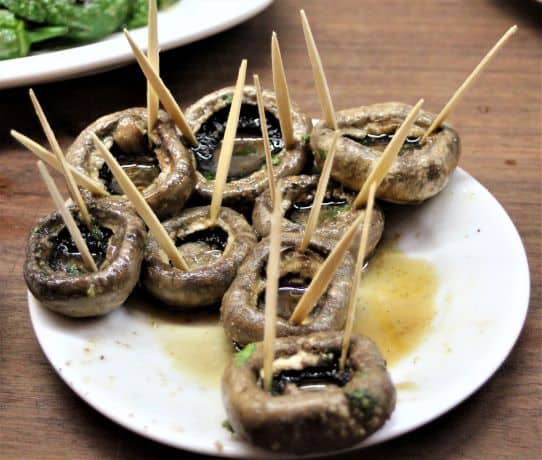
Cava de San Miguel, 17, 28005 Madrid, Spain
Casa Revuelta
Excellent tapas joint known for its cod.
Calle de Latoneros, 3, 28005 Madrid, Spain
Sanlucar
Andalusian tapas. The place for a glass of sherry.
Calle de San Isidro Labrador, 14, 28005 Madrid, Spain
Gourmet Experience
Food hall on the 9th floor of El Corte Ingles.
Centro Comercial El Corte Inglés, Plaza del Callao, 2, 28013 Madrid, Spain
La Ideal
The place to get calamari roll.
Calle de Botoneras, 4, 28012 Madrid, Spain
La Casa del Abuelo
Authentic tapas joint.
Calle de la Victoria, 12, 28012 Madrid, Spain

Chocolateria San Gines
The place for churros y chocolate.
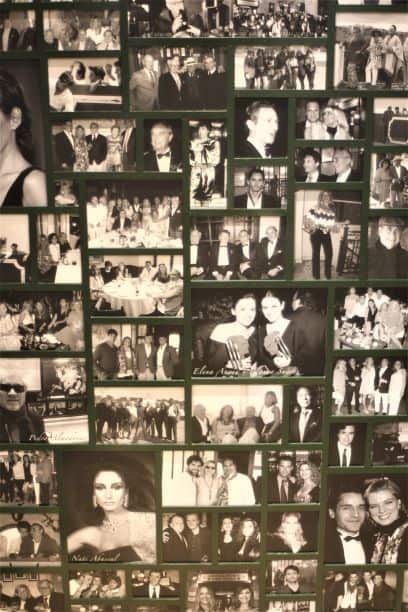
Pasadizo de San Gines 5, 28013 Madrid, Spain
La Mallorquina
Restaurant and bakery. The place to get Napolitana de chocolate.
Prta del Sol, 8, 28013 Madrid, Spain
Txrimiri
Great Basque tapas.
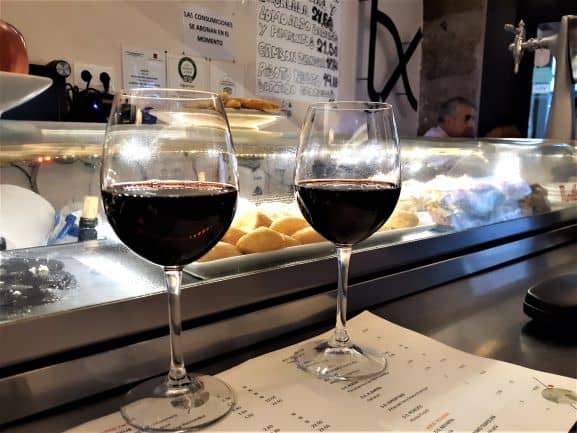
Taberna Almería
The place for Tostas (toast with toppings).
Calle de las Aguas, 9, 28005 Madrid, Spain
Taberna los Huevos de Lucio
Great spot for eggs, especially Huevos Rotos.
Calle de la Cava Baja, 32, 28005 Madrid, Spain
Casa Labra
Famous for their cod.
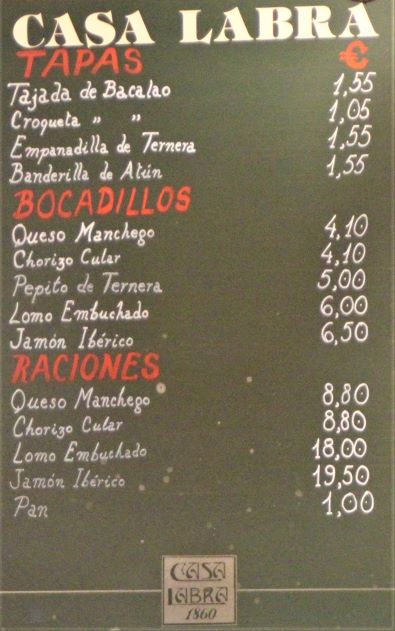
Calle de Tetuán, 12, 28013 Madrid, Spain
El Anciano Rey de los Vinos
Tapas and wine bar with Vermut de grifo (Vermouth on tap).
Calle de Bailén, 19, 28013 Madrid, Spain
Casa Gonzalez
Family run place has been making great tapas for almost 90 years.
Calle del León, 12, 28014 Madrid, Spain
La Sanabresa
Home style Spanish restaurant.
Calle del Amor de Dios, 12, 28014 Madrid, Spain
Casa Toni
Excellent and inexpensive tapas.
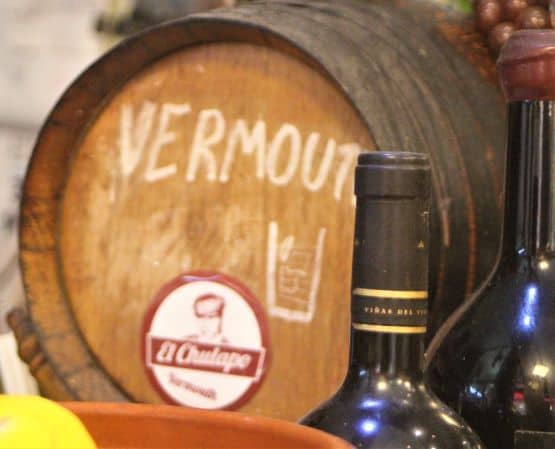
Calle de la Cruz, 14, 28012 Madrid, Spain
Casa Alberto
Great atmosphere in this tapas place that has been operating for almost 200 years.
Calle de las Huertas, 18, 28012 Madrid, Spain
La Berenjena
Bar with some delightful food.
Calle Marques de Toca 7, 28012 Madrid, Spain
La Terraza del Casino
Chef Paco Rancero’s restaurant has earned two Michelin stars.
Calle de Alcalá, 15, 28014 Madrid, Spain
Viridiana
Cozy restaurant manned by famous Chef Abraham Garcia.
Calle de Juan de Mena, 14, 28014 Madrid, Spain
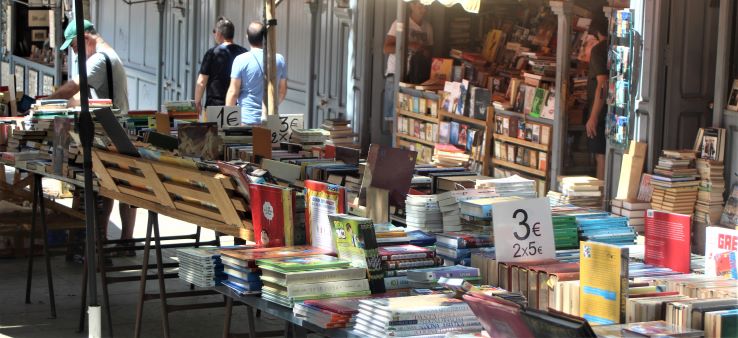
El Riojano
Historic pastry shop with authentic Spanish sweets. Still sells their famous cookies to the Spanish royal family.
Calle Mayor, 10, 28013 Madrid, Spain
Lateral Santa Ana
Pinchos (snacks) and cocktails.
Plaza de Sta. Ana, 12, 28012 Madrid, Spain
Museo Chicote
Cocktail bar made famous by Ernest Hemingway.
Calle Gran Vía, 12, 28013 Madrid, Spain
Pez Tortilla
Quite possibly the best tortillas in Madrid. Good craft beer list, too.
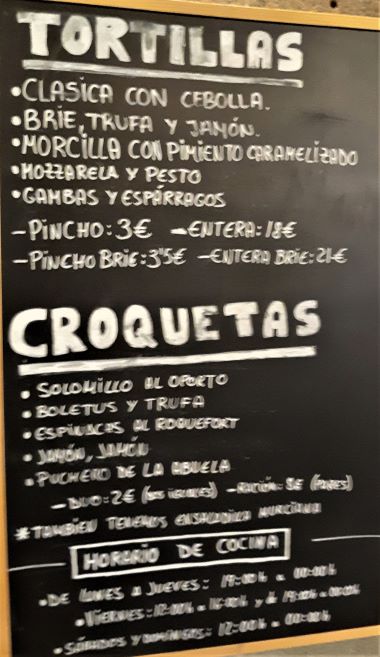
Calle del Pez, 36, 28004 Madrid, Spain
La Buena Vida
One of the Madrid’s most respected restaurants.
Calle del Conde de Xiquena, 8, 28004 Madrid, Spain
Tasca Celso y Manolo
Crowded but excellent tapas.
Calle de la Libertad, 1, 28004 Madrid, Spain
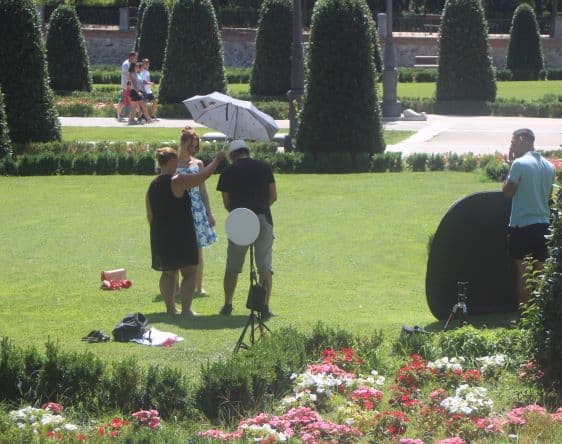
Taberna La Carmencita
Traditional Spanish dishes, including excellent huevos rotos.
Calle de la Libertad, 16, 28004 Madrid, Spain
Angelita Madrid
Restaurant with a great wine bar.
Calle de la Reina, 4, 28004 Madrid, Spain
Lolina Vintage Cafe
Cafe that takes you back to the 1970’s.
Calle del Espíritu Santo, 9, 28004 Madrid, Spain
1862 Dry Bar
Unique cocktail bar.
Calle del Pez, 27, 28004 Madrid, Spain
Del Diego Cocktail Bar
Huge selection of well-made cocktails.
Calle de la Reina, 12, 28004 Madrid, Spain
Café Manuela
Coffee, cocktails, board games. Fun spot.
Calle de San Vicente Ferrer, 29, 28004 Madrid, Spain
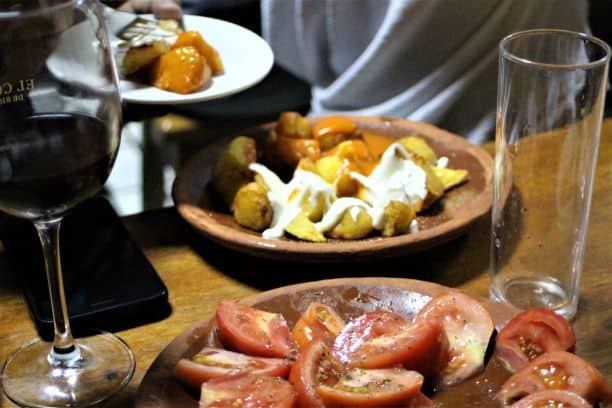
La Terraza del Urban
Chill rooftop bar.
Carrera de S. Jerónimo, 34, 28014 Madrid, Spain
Fogg Bar Birras & Cheese
Craft beer and cheese. What more do you need out of life?
Calle Moratin 5, 28014 Madrid, Spain
Jazz Bar
No live jazz, but a great soundtrack while enjoying a cocktail.
Calle Moratin 35, Zona Huertas, 28014 Madrid, Spain
Cervecería Alemana
One of Heminway’s spots for beer and/or coffee.
Plaza de Sta. Ana, 6, 28012 Madrid, Spain
La Venencia
Sherry bar complete with old barrels.
Calle Echegaray 7, 28014 Madrid, Spain
Salmon Guru
Unique cocktails served creatively. Named one of the 50 best bars in the world.
Calle de Echegaray, 21, 28014 Madrid, Spain

El Imperfecto
Cool bar, great mojitos.
Plaza de Matute, 2, 28012 Madrid, Spain
El 7 de la Cava
Delicious house made vermouth.
Calle de la Cava Baja, 7, 28005 Madrid, Spain
Delic
Excellent mojitos and fun desserts.
Costanilla de San Andrés, 14, 28005 Madrid, Spain
Taberna Bodegas Ricla
Authentic and tiny wine bar.
Calle de Cuchilleros, 8, 28005 Madrid, Spain
Astrolabius
Cute, family-run spot.
Calle Serrano, 118, 28006 Madrid, Spain
Estay
Good tapas. Open for breakfast, too.
Calle de Hermosilla, 46, 28001 Madrid, Spain
Docamar
Excellent Patatas Bravas.
Calle de Alcalá, 337, 28027 Madrid, Spain
Mallorca Pasteleria
Nice bakery and a good place to grab provisions for a picnic.
Restaurante Adolfo
High end dining in Toledo
Cerro del Emperador, S/N, 45002 Toledo, Spain
Index of Shopping in Madrid
Mercado de San Miguel
Gourmet food for picnics or taking home.
Plaza de San Miguel, 5, 28005 Madrid, Spain
Mercado de la Paz
Indoor market filled with food shops and artisans.
Calle de Ayala, 28B, 28001 Madrid, Spain
De Viaje
Both a travel bookstore and travel agency. A few English titles.
Calle Serrano, 41, 28001 Madrid, Spain
Mantequerías Bravo
A top gourmet food shop in Madrid. Mostly locals shopping here.
Calle de Ayala, 24, 28001 Madrid, Spain
Cuarto de Juegos
Toy store.
Calle de Jorge Juan, 42, 28001 Madrid, Spain
Patrimonio Comunal Olivarero
The place to get Spanish olive oil.
Calle Mejia Lequerica 1, 28004 Madrid, Spain
Oleoteca Gourmet La Chinata
Gourmet gift shop with olive oil, paprika, etc.
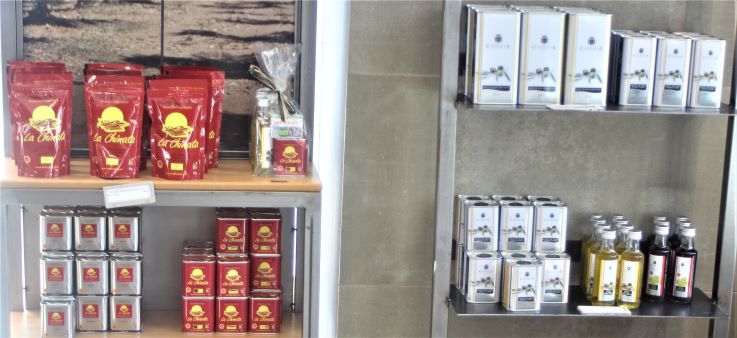
Calle Mayor, 44, 28013 Madrid, Spain
Antigua Casa Talavera
The place for authentic Spanish ceramics.
Calle de Isabel la Católica, 2, 28013 Madrid, Spain
Casa de Diego
The shop for authentic fans and shawls.
Puerta del Sol, 12, 28013 Madrid, Spain
Mercado Antón Martin
Excellent local food hall.
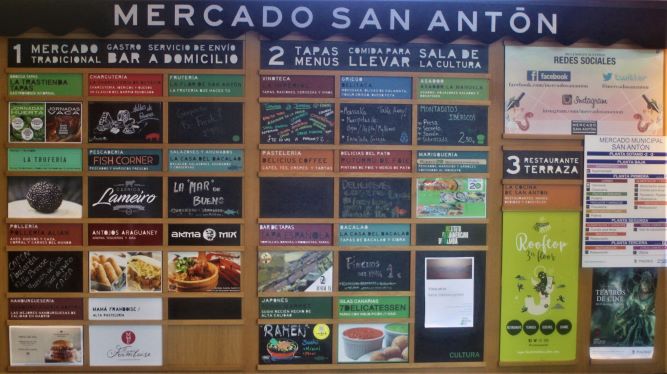
Calle de Santa Isabel, 5, 28012 Madrid, Spain
Flamenco Vive
Flamenco guitars, CDs, and costumes.
Calle de Moratín, nº 6, 28014 Madrid, Spain
Capas Sesena
Handmade (and spendy) capes for men and women.
Calle de la Cruz, 23, 28012 Madrid, Spain
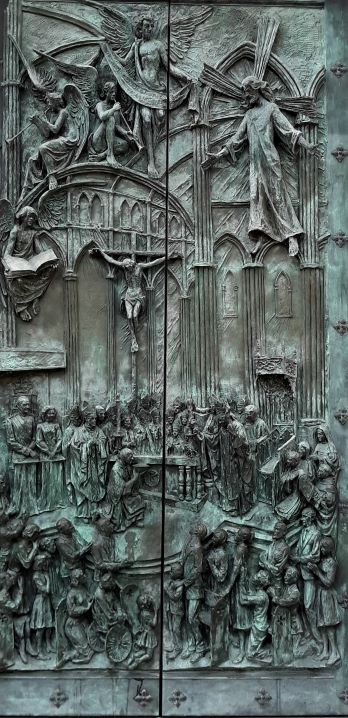
Licores Cabello
Top-notch wine shop.
Calle de Echegaray, 19, 28014 Madrid, Spain
Mercado de Vallehermoso
Smaller food hall with local charm.
Calle de Vallehermoso, 36, 28015 Madrid, Spain
Index of Places to Stay in Madrid
Central Palace
Cute boutique hotel with perfect location across from the Royal Palace.
Plaza de Oriente, 2, 28013 Madrid, Spain
Dear Hotel Madrid
Stylish hotel in Plaza de Espana.
Calle Gran Vía, 80, 28013 Madrid, Spain
Casual Madrid del Teatro
No frills option with theater decor.
Calle de Echegaray, 1, 28014 Madrid, Spain
7 Islas Hotel
Nice hotel in Malasaña
Calle de Valverde, 14, 28004 Madrid, Spain
Meliá Madrid Princesa
Sleek hotel in Malasaña.
Calle Princesa 27, 28008 Madrid Spain
Palacio Plaza Conde de Miranda
Apartments decorated in TV and film motifs like TinTin
Plaza Conde de Miranda 1, 28005 Madrid Spain
About the Author

Brent Petersen is the Editor-in-Chief of Destination Eat Drink. He currently resides in Setubal, Portugal. Brent has written the novel “Truffle Hunt” (Eckhartz Press) and the short story collection “That Bird.” He’s also written dozens of foodie travel guides to cities around the world on Destination Eat Drink, including in-depth eating and drinking guides to Spain’s Sherry Triangle, Lisbon and Porto. Brent’s podcast, also called Destination Eat Drink, is available on all major podcasting platforms and is distributed by the Radio Misfits Podcast Network.
